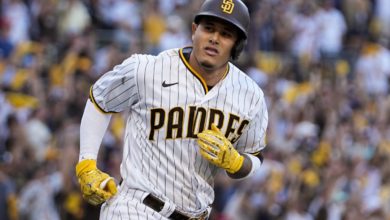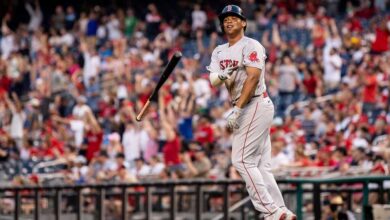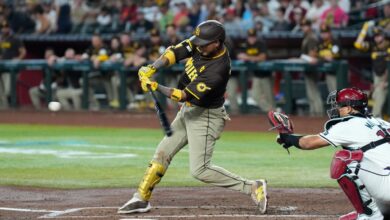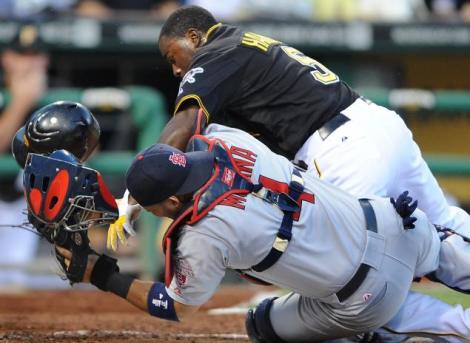
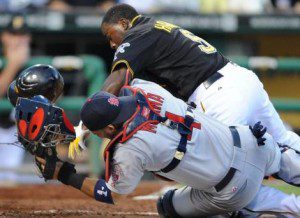
As many of you know, St. Louis Cardinals’ catcher Yadier Molina got freight-trained at the plate last week. He was clearly woozy, wobbling around like a boxer at the beginning of a standing eight-count. He would leave the game with multiple upper-body injuries and, I’m certain, a concussion, diagnosed or not. In one quick play — though not at the cost of a run, as Molina somehow hung onto the ball — the Cardinals lost one of their centerpieces, and one of the game’s best overall catchers, just at the start of the home stretch. As happens every time this sort of whopping plate collision takes someone out of a game — as when the Giants lost rising star Buster Posey last year to an ugly ankle roll — at least a few people, myself included, revisit the question: Is there some way to stop this from happening?
The hit on Molina was clean, as those kinds of hits go. The Pittsburgh Pirates’ Josh Harrison arrived at full tilt, in a close game, and a sturdy and well-armored catcher was standing in his way. In baseball-legal and somewhat customary fashion, Harrison lowered his shoulder and ran through the catcher, trying to dislodge the ball. Interestingly, last year Harrison was actually injured on a similar play, when he elected to slide instead of freight-train; this time, he must have been thinking, “I’m not getting the worst of this one.” Still, he didn’t aim for the head or knees, or appear to put any extra oomph into the hit. He just ran through the catcher, as in many quarters he’s fully expected to do. Nevertheless, Molina was injured — and the playoff race, not to mention Molina’s career trajectory, was possibly affected.
Baseball only has one situation in which running through an opposing player, football-style, is permitted: the collision at home plate. While it’s an exciting play, often ramping up the drama or intensity of a game, it’s occasionally had grave consequences — such as when Pete Rose blasted Ray Fosse at the plate, dislocating his shoulder (in an All-Star game!), or last year’s collision that ended Buster Posey’s year. Every time I see hits like the ones above, I think: Someday, we’re going to have a perfect-storm home plate collision, and something really, really bad is going to happen.
The question is, what can be done?
As evidenced by the Molina-Harrison play, there’s an extent to which plate collisions are a structural consequence of baseball. If a runner is barreling toward home, and there’s a fielder trying to throw them out, there’s a chance that ball and baserunner will arrive at or around the same time. When this happens, both base runner and fielder are beholden to duties that are mutually exclusive, and when both adhere to said duty, some kind of collision will ensue. So again, where does this leave us?
I think one possible approach is to try to eliminate the cavalier attitude many have about the play. At times, it’s seemed like a point of pride to catchers that they can get knocked into next week and get up holding the ball. Similarly, it’s seemed like some players have gone through the catcher more interested in making an NFL “jacked up” highlight than just scoring the run. When a catcher camps out in the baseline well before the throw arrives, daring the runner to go through them, this should be ruled interference. When a runner is judged to have used excessive force to run through the catcher, it should be the umpire’s prerogative to call them out. Both of these modifications have precedent in existing, albeit poorly and inconsistently applied, rules: It is the umpire’s discretion to award an extra base on a ground rule double, for example, if they determine that the runner would have made it to that base even if the ball had remained in play. An ump can deny first base to a batter who didn’t, in their estimation, make an attempt to avoid a pitched ball. Both of these rules are rarely actually enforced by umpires, but a more oft-used example is catcher’s interference, when the catcher’s mitt hits the bat while it’s being swung. The point is, there is precedent in baseball for the sort of judgment call I’m suggesting.
Of course, there are obvious challenges. Anyone who remembers the period when the American League strike zone seemed to only go as high as the belt, while the National League strike zone seemed to occasionally range three inches off the outside corner, can attest to the hazards of leaving something like the scoring of a run up to the (insert expletive) umpires. And anyone who’s watched NFL football since they began (with good reason, in my opinion) to regulate launching-pad collisions in an attempt to address the concussion problem, has probably seen or read about a questionable or controversial game-altering call determining the intent and/or recklessness of a hit that would have once just made the highlight reel. I fully anticipate being apoplectic over some harebrained application of rules I am herein suggesting, as I am now sometimes apoplectic over the personalized strike zones, quick triggers and “rabbit ears” still exhibited by some major league umpires. But the alternative, in my opinion, has much worse consequences. Players are bigger, stronger and faster in every sport. Sooner or later, if Major League Baseball doesn’t begin to regulate plate collisions, the aforementioned perfect-storm collision is going to happen. It might happen anyway, but at least the likelihood can be decreased by trying to make the game safer.


